1997 BUICK REGAL air condition
[x] Cancel search: air conditionPage 331 of 422
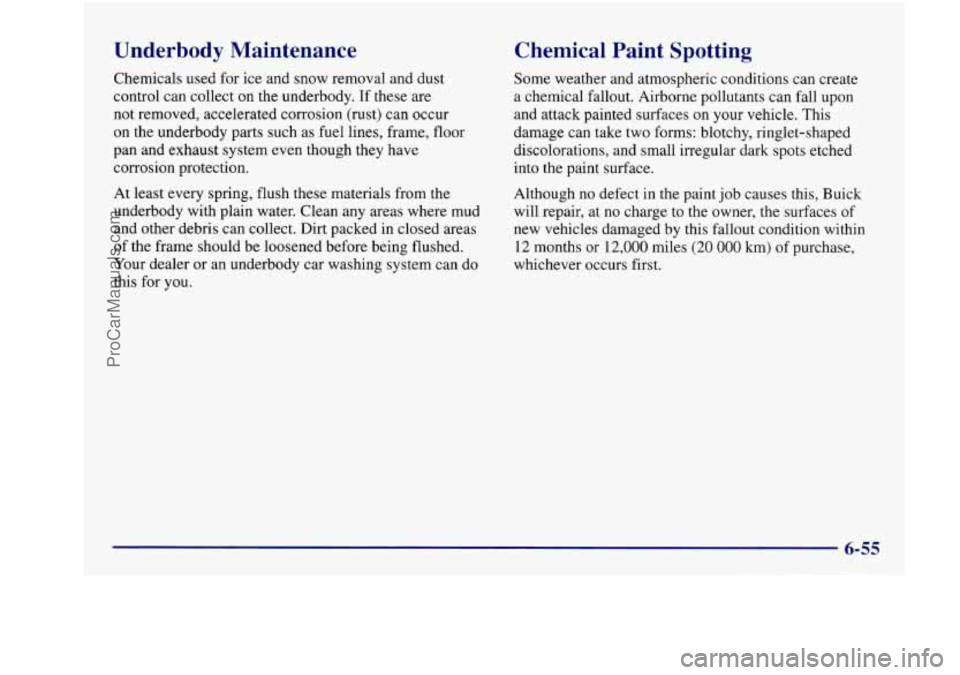
Underbody Maintenance
Chemicals used for ice and snow removal and dust
control can collect
on the underbody. If these are
not removed, accelerated corrosion (rust) can occur
on the underbody parts such as fuel lines, frame, floor
pan and exhaust system even though they have
corrosion protection.
At least every spring, flush these materials from the
underbody with plain water. Clean any areas where mud
and other debris can collect. Dirt packed in closed areas
of the frame should be loosened before being flushed.
Your dealer or an underbody car washing system can do
this for you.
Chemical Paint Spotting
Some weather and atmospheric conditions can create
a chemical fallout. Airborne pollutants can fall upon
and attack painted surfaces on your vehicle. This
damage can take two forms: blotchy, ringlet-shaped
discolorations, and small irregular dark spots etched
into the paint surface.
Although no defect in the paint
job causes this, Buick
will repair, at
no charge to the owner, the surfaces of
new vehicles damaged by this fallout condition within
12 months or 12,000 miles (20 000 km) of purchase,
whichever occurs first.
ProCarManuals.com
Page 339 of 422
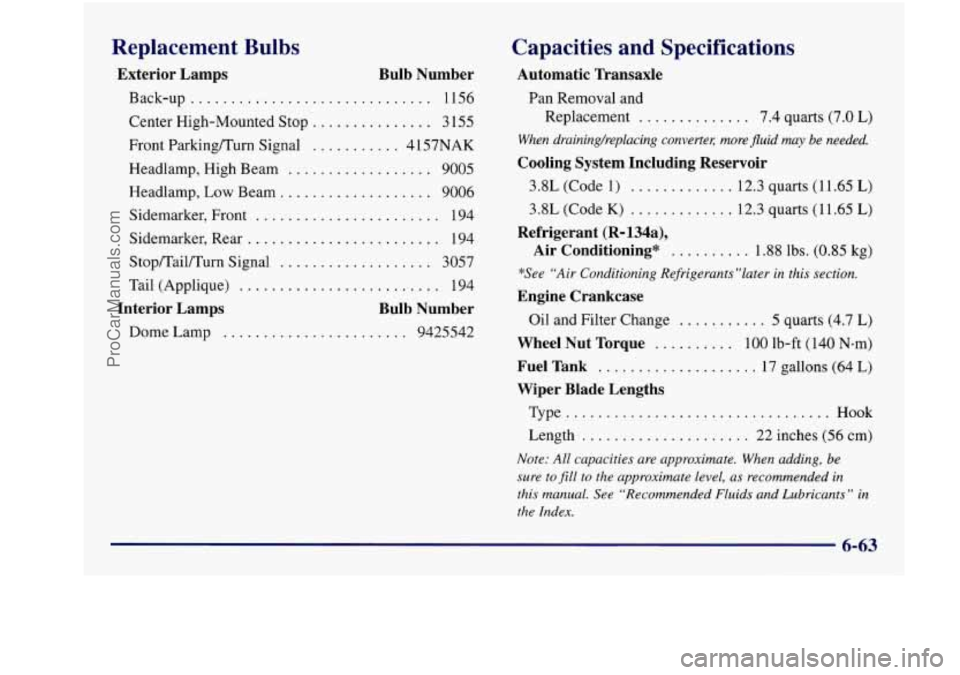
Replacement Bulbs
Exterior Lamps Bulb Number
Back-up .............................. 1156
Center High-Mounted Stop
............... 3 155
Front Parking/Turn Signal
........... 4 157NAK
Headlamp, High Beam
.................. 9005
Headlamp,
Low Beam. .................. 9006
Sidemarker, Front
....................... 194
Sidemarker, Rear
........................ 194
Stop/Tail/Turn Signal
................... 3057
Tail (Applique)
......................... 194
Interior Lamps Bulb Number
Dome Lamp ....................... 9425542
Capacities and Specifications
Automatic nansaxle
Pan Removal and
Replacement
.............. 7.4 quarts (7.0 L)
When drainingheplacing converter; more fluid my be needed.
Cooling System Including Reservoir
3.8L (Code 1) ............. 12.3 quarts (1 1.65 L)
3.8L (Code K) ............. 12.3 quarts (1 1.65 L)
Air Conditioning* .......... 1.88 lbs. (0.85 kg)
Refrigerant (R=134a),
*See “Air Conditioning Refrigerants”1ater in this section.
Engine Crankcase
Oil and Filter Change ........... 5 quarts (4.7 L)
Wheel Nut Torque .......... 100 lb-ft (140 N-m)
Fuel Tank .................... 17 gallons (64 L)
Wiper Blade Lengths
Type ................................. Hook
Length ..................... 22 inches (56 cm)
Note: All capacities are approximate. When adding, be
sure to
fill to the approximate level, as recommended in
this manual. See “Recommended Fluids and Lubricants
” in
the Index.
6-63
ProCarManuals.com
Page 341 of 422
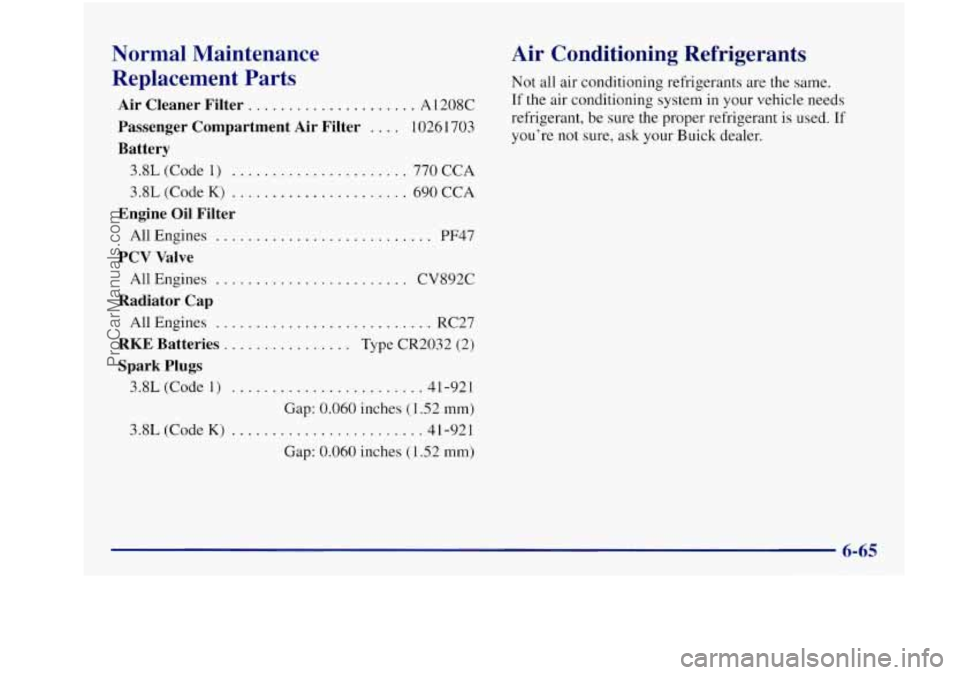
Normal Maintenance
Replacement Parts
Passenger Compartment Air Filter .... 10261 703
Air Cleaner Filter ..................... A 1208C
Battery
3.8L (Code 1) ...................... 770 CCA
3.8L (Code K) ...................... 690 CCA
Engine Oil Filter
All Engines ........................... PF47
PCV Valve
All Engines ........................ CV892C
Radiator Cap
All Engines ........................... RC27
RKE Batteries ................ Type CR2032 (2)
Spark Plugs
3.8L (Code 1) ........................ 41-921
Gap:
0.060 inches (1.52 mm)
3.8L (Code
K) ....................... .41-921
Gap: 0.060 inches (1.52
mm)
Air Conditioning Refrigerants
Not all air conditioning refrigerants are the same.
If the air conditioning system in your vehicle needs
refrigerant, be sure the proper refrigerant is used. If
you’re not sure, ask your Buick dealer.
ProCarManuals.com
Page 344 of 422
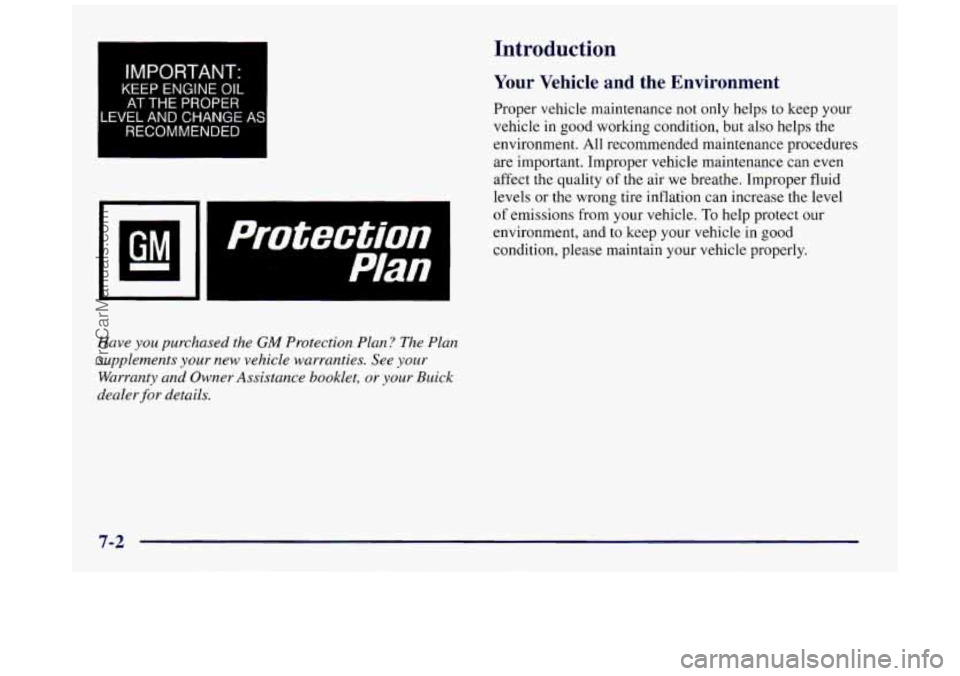
Introduction
IMPORTANT:
KEEP ENGINE OIL
AT THE PROPER
IVEL AND CHANGE
RECOMMENDED
Have you purchased the GM Protection Plan? The Plan
supplements
your new vehicle warranties. See your
Warranty and Owner Assistance booklet, or your Buick
dealer
for details.
Your Vehicle and the Environment
Proper vehicle maintenance not only helps to keep your
vehicle in good working condition, but also helps the
environment. All recommended maintenance procedures
are important. Improper vehicle maintenance can even
affect the quality of the air we breathe. Improper fluid
levels or the wrong tire inflation can increase the level
of emissions from your vehicle.
To help protect our
environment, and to keep your vehicle in good
condition, please maintain your vehicle properly.
7-2
ProCarManuals.com
Page 345 of 422
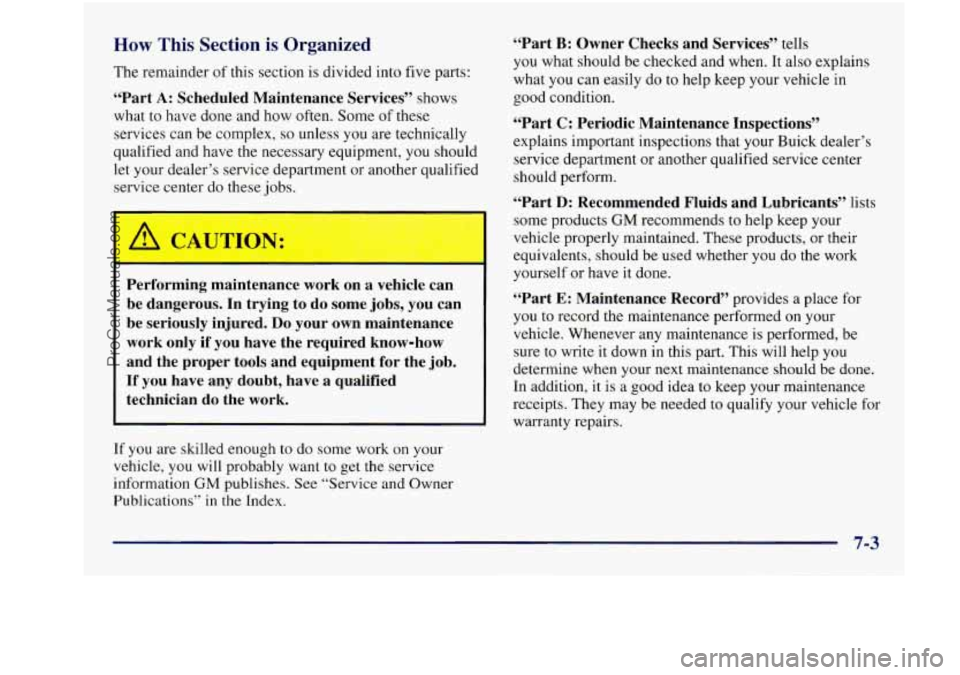
How This Section is Organized
The remainder of this section is divided into five parts:
“Part A: Scheduled Maintenance Services” shows
what to have done and how often. Some
of these
services can be complex,
so unless you are technically
qualified and have the necessary equipment, you should
let your dealer’s service department or another qualified
service center do these
jobs.
Performing maintenance work on a vehicle can
be dangerous. In trying to do some jobs, you can
be seriously injured.
Do your own maintenance
work only
if you have the required know-how
and the proper tools and equipment for the job.
If you have any doubt, have a qualified
technician do the work.
If you are skilled enough to do some work on your
vehicle, you will probably want to get
the service
information
GM publishes. See “Service and Owner
Publications’’ in the Index.
“Part B: Owner Checks and Services” tells
you what should be checked and when. It also explains
what you can easily do to help keep your vehicle in
good condition.
“Part C: Periodic Maintenance Inspections”
explains important inspections that your Buick dealer’s
service department or another qualified service center
should perform.
“Part D: Recommended Fluids and Lubricants” lists
some products
GM recommends to help keep your
vehicle properly maintained. These products, or their
equivalents, should be used whether you do the work
yourself or have it done.
“Part E: Maintenance Record” provides a place for
you to record the maintenance performed
on your
vehicle. Whenever any maintenance is performed, be
sure to write it down in this part. This will help you
determine when your next maintenance
should be done.
In addition, it
is a good idea to keep your maintenance
receipts. They may be needed to qualify your vehicle for
warranty repairs.
7-3
ProCarManuals.com
Page 346 of 422
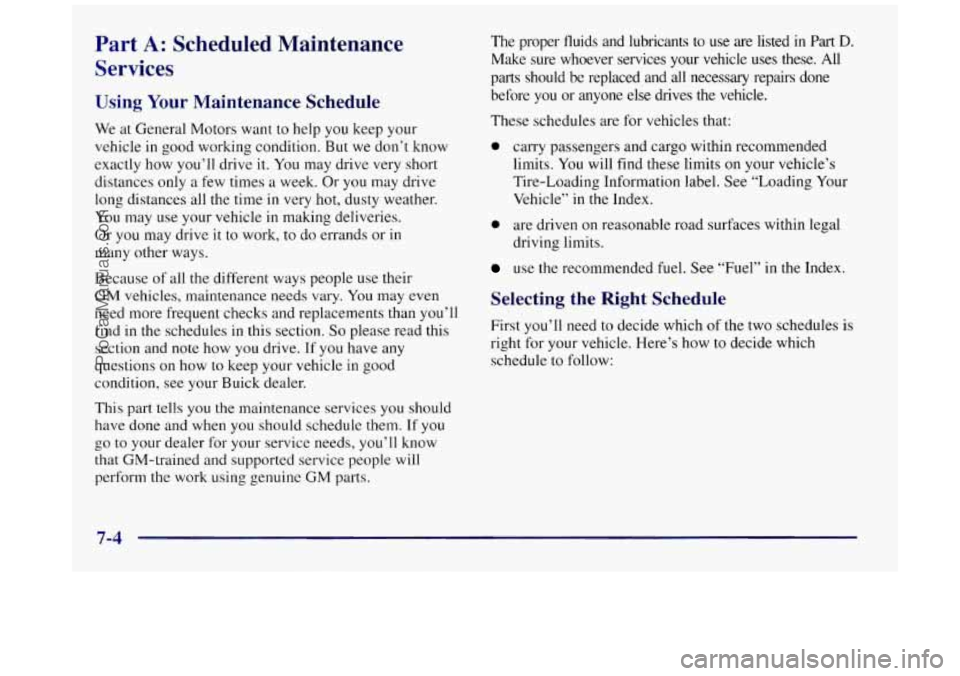
Part A: Scheduled Maintenance
Services
Using Your Maintenance Schedule
We at General Motors want to help you keep your
vehicle in good working condition.
But we don’t know
exactly how you’ll drive
it. You may drive very short
distances only a few times a week. Or you may drive
long distances all the time
in very hot, dusty weather.
You may use your vehicle in making deliveries.
Or you may drive it to work, to do errands or
in
many other ways.
Because
of all the different ways people use their
GM vehicles, maintenance needs vary. You may even
need more frequent checks and replacements than
you’ll
find in the schedules in this section. So please read this
section and note how you drive.
If you have any
questions on how to keep your vehicle in good
condition, see your Buick dealer.
This part tells you
the maintenance services you should
have done and when
you should schedule them. If you
go to your dealer for your service needs, you’ll know
that GM-trained and supported service people will
perform the work using genuine
GM parts. The
proper fluids and lubricants to
use are listed in Part D.
Make sure whoever services your vehicle uses these. All
parts should be replaced and all necessary repairs done
before you or anyone else drives the vehicle.
These schedules are for vehicles that:
0 carry passengers and cargo within recommended
limits. You will find these limits on your vehicle’s
Tire-Loading Information label.
See “Loading Your
Vehicle”
in the Index.
0 are driven on reasonable road surfaces within legal
driving limits.
use the recommended fuel. See “Fuel” in the Index.
Selecting the Right Schedule
First you’ll need to decide which of the two schedules is
right for your vehicle. Here’s how to decide which
schedule to follow:
7-4
ProCarManuals.com
Page 347 of 422
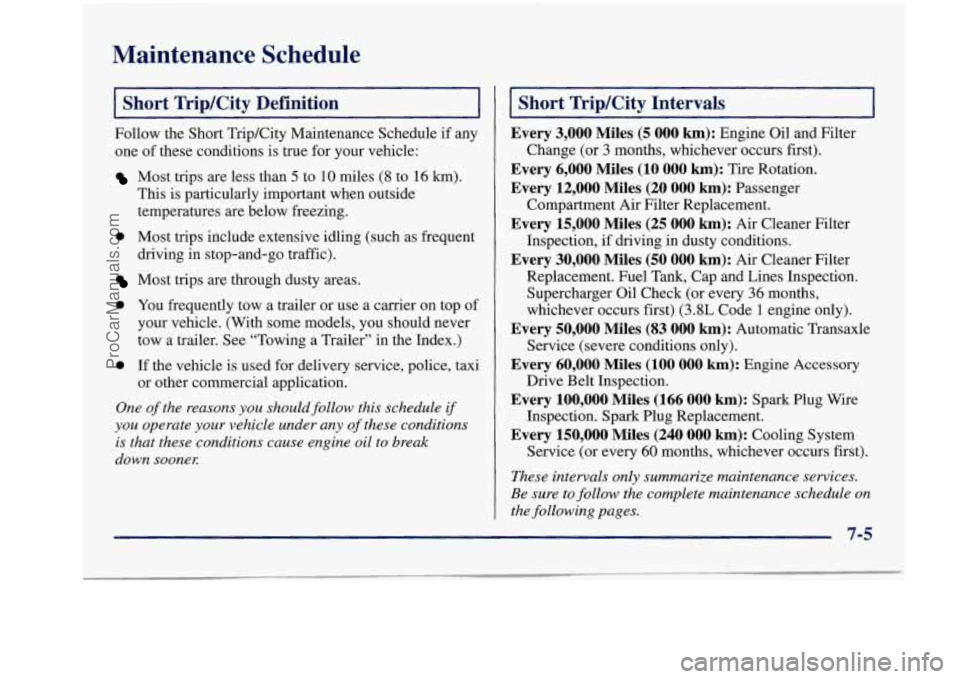
Maintenance Schedule
Short TripKity Definition
Follow the Short TripKity Maintenance Schedule if any
one of these conditions is true for your vehicle:
Most trips are less than 5 to 10 miles (8 to 16 km).
This is particularly important when outside
temperatures are below freezing.
0 Most trips include extensive idling (such as frequent
driving in stop-and-go traffic).
Most trips are through dusty areas.
0 You frequently tow a trailer or use a carrier on top of
your vehicle. (With some models, you should never
tow
a trailer. See “Towing a Trailer” in the Index.)
0 If the vehicle is used for delivery service, police, taxi
or other commercial application.
One
of the reasons you should follow this schedule if
you operate your vehicle under any of these conditions
is that these conditions cause engine oil to break
down soonel:
Short Trip/City Intervals
Every 3,000 Miles (5 000 km): Engine Oil and Filter
Change
(or 3 months, whichever occurs first).
Every 6,000 Miles (10 000 km): Tire Rotation.
Every 12,000 Miles (20 000 km): Passenger
Every 15,000 Miles (25 000 km): Air Cleaner Filter
Every 30,000 Miles (50 000 km): Air Cleaner Filter
Compartment Air Filter Replacement.
Inspection, if driving
in dusty conditions.
Replacement. Fuel Tank, Cap and Lines Inspection.
Supercharger Oil Check (or every 36 months,
whichever occurs first)
(3.8L Code 1 engine only).
Every 50,000 Miles (83 000 km): Automatic Transaxle
Service (severe conditions only).
Every 60,000 Miles (100 000 km): Engine Accessory
Drive Belt Inspection.
Every 100,000 Miles (166 000 km): Spark Plug Wire
Inspection. Spark Plug Replacement.
Every 150,000 Miles (240 000 km): Cooling System
Service (or every
60 months, whichever occurs first).
These intervals only summarize maintenance services.
Be sure to follow the complete maintenance schedule
on
the following pages.
I- 7-5
ProCarManuals.com
Page 348 of 422
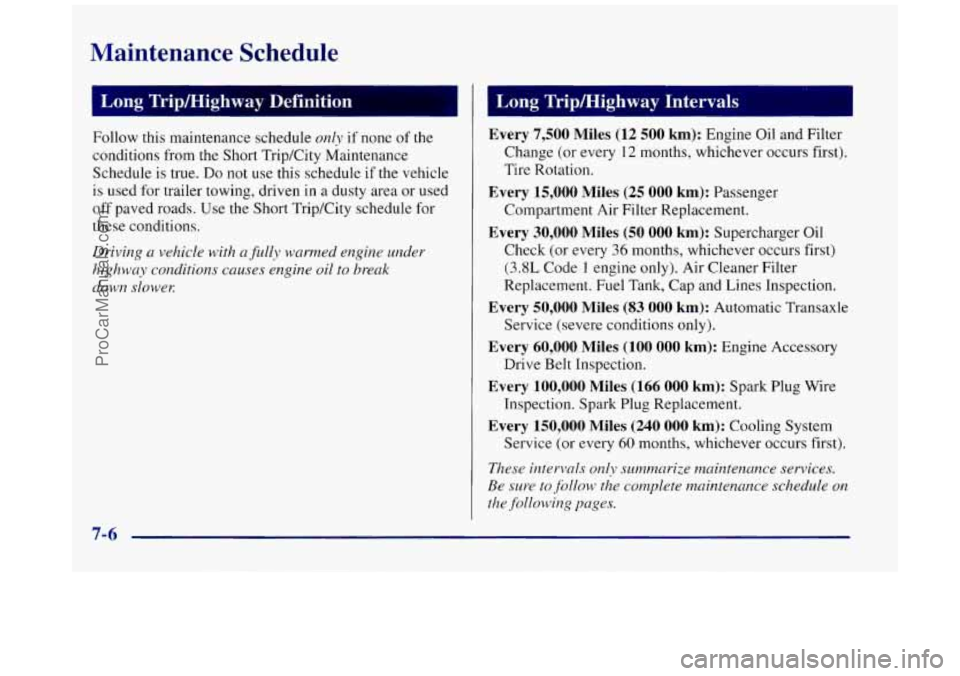
Maintenance Schedule
Follow this maintenance schedule only if none of the
conditions from
the Short TripKity Maintenance
Schedule is true.
Do not use this schedule if the vehicle
is used for trailer towing, driven in a dusty area or used
off paved roads. Use the Short Trip/City schedule for
these conditions.
Driving a vehicle with a fidly warmed engine under
highway conditions causes engine oil to break
down
slowex
Every 7,500 Miles (12 500 km): Engine Oil and Filter
Change (or every 12 months, whichever occurs first).
Tire Rotation.
Every 15,000 Miles (25 000 km): Passenger
Compartment Air Filter Replacement.
Every 30,000 Miles (50 000 km): Supercharger Oil
Check (or every
36 months, whichever occurs first)
(3.8L Code 1 engine only). Air Cleaner Filter
Replacement. Fuel Tank, Cap and Lines Inspection.
Every 50,000 Miles (83 000 km): Automatic Transaxle
Service (severe conditions only).
Every 60,000 Miles (100 000 km): Engine Accessory
Drive Belt Inspection.
Every 100,000 Miles (166 000 krn): Spark Plug Wire
Inspection. Spark Plug Replacement.
Every 150,000 Miles (240 000 km): Cooling System
Service (or every
60 months, whichever occurs first).
These intervals only summarize maintenance services.
Be sure to follow the complete nzaintenance schedule on
the following pages.
7-6
ProCarManuals.com